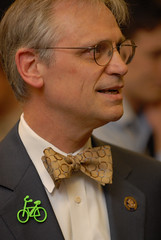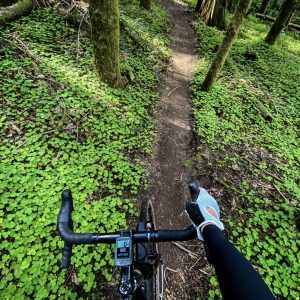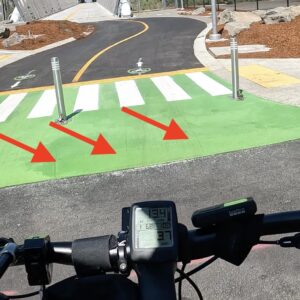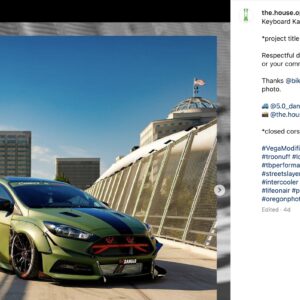With bipartisan support, U.S. Representative Earl Blumenauer (D-OR) has introduced a new bill — the Orphan Highway Restoration Act — aimed at improving state highways that run through America’s main streets.
According to Blumenauer, “orphan highways” are former U.S. numbered highways that over the years have lost traffic volume to more popular Interstate Highways.
In a press release about the bill Blumenauer says, the bill will direct funding toward improving these “abandoned” main streets:
“Improving and repairing America’s Main Streets will revitalize communities, create local business opportunities, and make these areas more livable for residents…restoring main thoroughfares is a smart way to improve quality of life and give local businesses a needed boost.”
Improvements that would be funded through this legislation would include sidewalks, medians, bikeways, and traffic signals. The bill would authorize $600 million each year from 2010 to 2015 – the duration of the transportation authorization.
Looking at the bill text, Blumenauer clearly wants this to result in more complete streets (emphasis mine):
“The Secretary shall make grants and provide technical assistance to States and units of local government to —
…rehabilitate, repair, or construct sidewalks, medians, bike lanes, traffic-calming devices, signaling, or signs to enhance community livability on or adjacent to an orphan highway.
In making grants under this section, the Secretary shall give priority to projects that —
…include rehabilitation measures that focus on pedestrian safety;
…promote cost-effective and strategic investments in transportation infrastructure facilities that minimize adverse impacts on the environment;
.. have zoning designations that support more intensive, mixed-use development along part or all of the route;”
There are several highways (most people think of them as streets) in the Portland area that would likely be eligible for this money (SE Martin Luther King Jr. Blvd (99E), SE Powell (26), 82nd Ave (Cascade Highway/213)), but the bill is mostly aimed at smaller towns. According to the bill text, at least 20% of the money must go to cities with between 50,000 and 250,000 residents and at least 50% of the money must go toward towns with less than 50,000 people.
This is an interesting bill. Blumenauer has tied investment in non-motorized vehicles to revitalizing Main Street America, and in so doing, he’s making a statement that dense development, better bikeways, and complete streets are directly tied to improved economic vitality. It will be fun to watch the debate and see how this turns out.
Download bill here (40KB, PDF)







Thanks for reading.
BikePortland has served this community with independent community journalism since 2005. We rely on subscriptions from readers like you to survive. Your financial support is vital in keeping this valuable resource alive and well.
Please subscribe today to strengthen and expand our work.
I ride 99w daily and that bike shoulder NEVER gets cleaned. I’m riding track tires through gravel, glass, trash and various other forms of road debris.
82nd Ave. is “Exhibit A” of Earl’s bill.
This is an interesting burb. How about more details of what will actually be effected in our state.
Good idea if we had even a good economy.
It’s not just about what you DO, it is about what you don’t do.
Earl, to save real money for all your pet projects I wish you would do more in the big money sucking budget areas, which when mentioned here, draw “off topic” fouls by your fans.
Does this make anyone else think of the movie Cars or is it just me?
While this Bill,should it be adopted, is a good first step,infrastructure improvements need to be tied with economic development along those corridors. There is a strong tie between car,malls, and the defacto abandonment of those roadways. Reading the Bill, I see that there is recognition of the need for zoning changes tied in with receiving Federal dollars, as well as connecting improvements with an investment of local government to fund and develop those adjacent properties for mixed use development and more intensive use. This Bill is also addressed towards smaller governmental units, between 50,000 to 250,000 population. So it’s unlikely Portland would see much benefit from this,but Gladstone,Milwaukie,Sandy would. This might be a good tool for communities that see the need and are energetic and imaginative, and yes, wealthy enough to use it as part of a comprehensive development program, such as the Main Streets Program.
$600 million annually sounds like a lot of money,but distributed nationally,I expect few projects locally,but since Blumenauer is the sponsor, I am sure there would be more attention paid in Oregon than in many other States.
Earl’s frickin awesome.
I live in a Washington congressmans’ district. The whole length of Highway 99 (what I-5 bypassed) has towns that could benefit from this. Those of us who don’t have an emotional need for bike lanes already know that many of these roads are good cycling roads–they are direct, often have very wide lanes and are graded more gently than residential streets. In other words, they’re perfect utilitarian cycling roads. Enhancements and just plain pothole filling would be great improvements. I’m calling Inslee’s office today to recommend that he support this!
I’ve cycled the entire length of old highway 99 all of the way from Everett, WA down to Portland, and then both 99W and 99E down to around Salem, and I can say from firsthand experience that this could really do wonders for some of those streets.
The first example that comes to mind that would benefit immensely from this would be the stretch of road known as NE Highway 99 through unincorporated Clark County, and continuing into downtown Vancouver as Main Street. A few easy upgrades could really do wonders for bicycles and pedestrians on this important corridor.
SW Hall Blvd in Tigard sounds like a perfect example… I’d love to see it get rehabilitated. Perhaps all the way out to Beaverton?
I love the idea of the old main street being rehabilitated, but have never liked the idea of the main highway going through the center of a small town. I like the idea of the highway going around the center of town and having a town square, or a pedestrian main street. Imagine if a highway dumped right though Prague’s Old Town Square. I lived in Sisters for a few years as a kid and the worst part about that neat little town was the highway and steady stream of cars, and loads of semi-trucks. I think livable small town caters to the residents, instead of, or in addition to tourist. Otherwise you just have a bunch of tchotchke shops and nothing really useful for everyday living – grocery, bakery, pubs, butcher, barber, hardware, etc.
Just thinking. Keep up the good work Earl!
I consult with, and sit a number of rural district city-councils around the state. This bill will fund some of the only bike infrastructure these areas are likely going to see.
Street racks, the dreaded bike-lanes, access, you name it, will be greatly improved in a lot of areas despite what happens in Portland.
Someone please tell me where all this mone is coming from these guys in Washington are spending? Oh, maybe it’s from you and I. Folks you are getting ready to see taxes imposed on you that you can’t even imagine. Fire these idiots and send them home. BTW when they finish spending all YOUR money it wont matter about revitalizing small businesses and communities…WAKE UP.
Dave, there is no need to use offensive terms here.